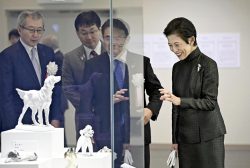
Left: A painting believed to be the portrait of the 13th monarch of the Ryukyu Kingdom, King Sho Kei. Right: A painting believed to be the portrait of the 18th monarch of the kingdom, King Sho Iku
1:00 JST, May 13, 2024
NAHA — Portraits of Ryukyu Kingdom (1429-1879) monarchs that had been missing since the Battle of Okinawa in the final phase of the World War II were found in the United States and returned to Okinawa Prefecture in March. The return of these authentic works of Ryukyuan art, which were influenced by China, is likely to give new insight into the uniqueness of Ryukyuan culture and its position in East Asia more broadly.
Value of national treasures
The portraits, known as “ogoe,” were painted when kings of the Ryukyu Kingdom passed away. Materials related to the Sho family, which founded the kingdom, are designated as national treasures, with ogoe depicting the authority of the kings being first-class resources.
The ogoe had been known about before they were found thanks to the survival of 10 black-and-white photographs taken in 1925 by Yoshitaro Kamakura, a dyeing and weaving artist and researcher of Okinawan culture. Through comparison with the photographs by Kamakura, one of the four ogoe that was returned was found to show the 13th monarch, King Sho Kei, who reigned in the first half of the 18th century, and another to be of the 18th monarch, King Sho Iku, who reigned around the middle of the 19th century.
Both paintings depict the king in the center of the painting, larger than surrounding people. This style can also be seen in the portraits of the emperors of the Ming and Qing dynasties of China, indicating Chinese influence.
Professor Kei Arai of the Tokyo University of the Arts, who was involved in the restoration and reproduction of several ogoe, including that of King Sho Iku, said, “The gold leaf used around the king’s image looks more magnificent than I expected.”
Use of perspective
Kazuyuki Tomiyama, a professor emeritus at the University of the Ryukyus and scholar on Ryukyu history, focuses on the depiction of the kings’ clothing in the ogoe. In China, the clothing in emperors’ portraits changed with the change of dynasties, but while the Ryukyu kings’ clothes were made from fabrics gifted by the Qing dynasty, they reportedly kept the style of Ming court.
“It seems likely that while the Ryukyu Kingdom was greatly influenced by China, it also incorporated its own unique style,” said Tomiyama. “Analyzing what has adhered to the ogoe, such as soot from incense, will clarify how the ogoe were used in ceremonies,” he added, expressing his hope that the ogoe will help elucidate the spiritual history of the Ryukyu Kingdom.
“The ogoe were made using the best materials and techniques of the time, and with the originals, we can trace the changes in Ryukyuan painting,” said Nobuyuki Hirakawa, chief curator at the Okinawa Prefectural Museum and Art Museum specializing in the history of Ryukyuan paintings, who has been researching ogoe.
The West’s rules of perspective, which came to the Ryukyu Kingdom through China, can be seen in the shadows of the crown beads, he said. “These ogoe are very valuable in that they will enable us to study where Ryukyuan paintings can be positioned in the history of East Asian paintings.”

A photograph by Yoshitaro Kamakura of a portrait depicting the 18th monarch of the kingdom (This image is owned by the Library and Arts Museum of Okinawa Prefectural University of Arts.)
"Culture" POPULAR ARTICLE
-

Van Cleef & Arpels Dazzles with Art Deco Artisanry at Tokyo Exhibit
-

Disney’s ‘Twisted-Wonderland’ Animated Series Puts Villains in Spotlight: New Show Features School Inspired by Classic Disney Films
-

Ayumi Hamasaki’s Shanghai Concert Canceled Day Before Schedule as Part of Beijing Backlash
-

‘The World Masterpiece Theater Series’ Celebrates 50 Years; Animator Looks Back on Creating Anime Classics
-

Popularity of Piggy Banks Across Time and Place Seen at Bank’s Museum of Money Boxes in Hyogo Pref.
JN ACCESS RANKING
-

Tokyo Economic Security Forum to Hold Inaugural Meeting Amid Tense Global Environment
-

Keidanren Chairman Yoshinobu Tsutsui Visits Kashiwazaki-Kariwa Nuclear Power Plant; Inspects New Emergency Safety System
-

Imports of Rare Earths from China Facing Delays, May Be Caused by Deterioration of Japan-China Relations
-

University of Tokyo Professor Discusses Japanese Economic Security in Interview Ahead of Forum
-

Japan Pulls out of Vietnam Nuclear Project, Complicating Hanoi’s Power Plans
























